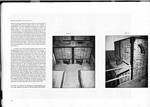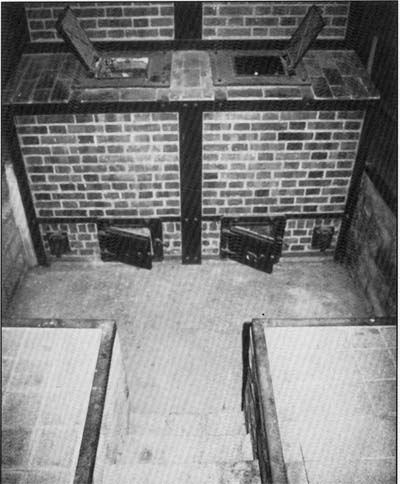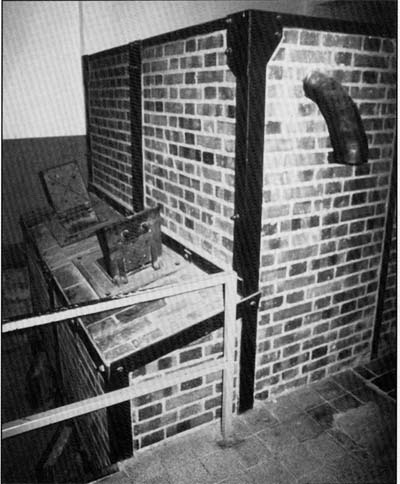|
|
 |
 |
AUSCHWITZ:
Technique
and Operation
of
the Gas Chambers © |
|
|
| |
 |
Back |
 |
Contents |
Page 110 |
 |
Home
Page |
Forward |
 |
| |
 |
Photo 2d |
| |
Photos 2a, 2b, 2c and 2d
[Photos by Michel Folco] |
| |
Front (2a), side (2b), side/rear (2c) and
rear (2d) views of the Topf coke-fired double-muffle furnace installed under
the New Hospital of Mauthausen KL. Its metal components were first sent to
Auschwitz in August 1942, where there was talk of installing the furnace near
Birkenau Bunkers 1 and 2, before they were finally sent on to their correct
destination. It would appear that they were left in storage for over a year
before the furnace was actually built in July 1944. It did not enter service
until April 1945, and even then was used very little, or according to some
sources not at all. Photos 2b and 2c show the external part of the
pulsed air duct leading to the crematorium muffle, but the blower and its motor
have been removed. The place where they were installed can be seen on the floor
below the duct, where the patch of cement contrasts with the tiled surround of
the furnace. In the lower center on Photo 2b there is one of the secondary air intakes.
There were six of these, their purpose being to cool the furnace if it tended
to overheat (muffle temperature over 1100 C°).
A furnace of
the same model had already been ordered by KL Mauthausen from Topf in November
1940 for the Gusen subcamp. It cost 9,003 RM and entered service in January
1941. Its throughput is known from notes made by the prisoners in November
1941, when 600 corpses were cremated in a period of 12 days. This gives an
average of exactly 50 corpses a day for the furnace, or 25 corpses per muffle,
a rate of roughly one corpse per muffle per hour. This is a modest performance
compared with Auschwitz Krematorium I, where the rate was a little over two
corpses per muffle per hour. The ratios between the cremation rates of the
double-muffle furnaces at Auschwitz and that at Gusen were between 2:1 and 3:1
and those between the three-muffle furnaces at Birkenau and the one at
Buchenwald over 10:1. As the furnaces were virtually identical as regards
design and construction, they must have had roughly the same performance, so
that it is difficult to believe the extremely high rates claimed for
Auschwitz-Birkenau. Knowing that the official cremation rates communicated by
the Auschwitz SS to their superiors in Berlin (letter of 28th June 1943) were
entirely theoretical, being obtained by calculation and intended above all to
demonstrate the "efficiency" of the camp, it is necessary to correct
them. Even reduced by one-third, the "official" figure is barely
credible. The bragging SS usually multiplied the true figured by a factor of 2
to 5, and where comparisons are possible, division by something in this range
brings the totally unrealistic into the realm of the possible.
[The
details concerning the KL Mauthausen cremation furnaces were very kindly
supplied to the author by Mr. Pierre Serge CHOUMOFF.] |
| |
|
| Photo
2c |
 |
| |
|
| |
AUSCHWITZ:
Technique and operation
of the gas
chambers
Jean-Claude Pressac
© 1989, The Beate Klarsfeld Foundation |
 |
Back |
Page 110 |
Forward |
 |
|

